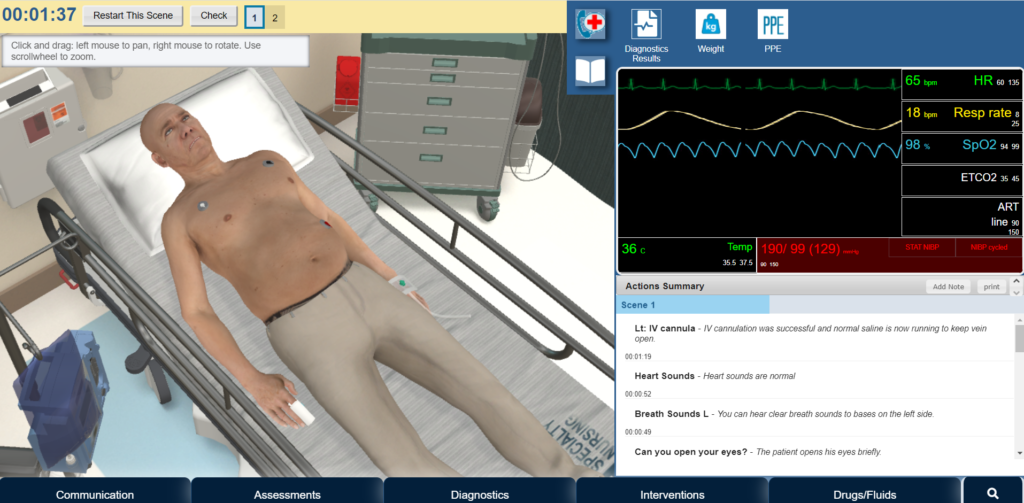About the SoHS Virtual Simulation Program
The Virtual Simulation Program is a key part of BCIT’s School of Health Sciences (SOHS) Simulation Program. We support innovative, technology-enhanced learning for Health Sciences students by offering a wide spectrum of virtual environments that simulate real-world health care experiences.
What is Virtual Simulation?
Virtual Simulation leverages digital tools and platforms to recreate clinical scenarios that students may encounter in practice. These environments allow learners to develop their clinical reasoning, decision-making, and communication skills in a safe and flexible setting, whether independently or as part of a guided learning experience.
At BCIT, we’ve developed and implemented a variety of virtual simulations ranging from low fidelity to high fidelity, ensuring accessibility and relevance across different programs and learning objectives. Examples include EdEHR, Affinity Learning, Virtual Pulse, Virtual Reality and more. More information about each of these platforms are provided below.
Virtual Simulation Enhances Student Learning
These simulations offer students the opportunity to engage with complex clinical cases in a safe environment that promotes learning through practice and reflection. They provide flexibility for learners to explore scenarios at their own pace, repeat experiences, and receive targeted feedback.
Benefits include:
- Skill-building in clinical judgment, documentation, and communication
- Practice with both common and rare clinical presentations
- Opportunities to make and learn from mistakes without real-world consequences
- Increased confidence and preparedness before clinical placements
Examples of Virtual Simulation in SoHS Programs
Educational Electronic Health Record (EdEHR)
Developed in partnership with BCIT, EdEHR is an interactive electronic health record platform designed with input from faculty and simulation experts. It helps students practice digital charting, interpret patient data, and build clinical documentation skills in a realistic, web-based environment. Alongside EdEHR, BCIT also uses LIS (Laboratory Information System) to teach students how to manage and analyze lab results, providing a comprehensive approach to clinical data management across patient records and laboratory information systems.
Affinity Learning
Affinity provides interactive, narrative-based simulations that mirror real-world healthcare scenarios. Its authoring tool enables educators to design customized, curriculum-aligned cases that promote critical thinking. Students engage with dynamic, case-based scenarios that encourage them to apply clinical knowledge and think critically. At BCIT, Affinity is integrated into multiple School of Health Sciences programs to strengthen case-based learning.
Virtual Pulse
Virtual Pulse is a high-fidelity, web-based simulation platform that provides access to high-risk, low-frequency clinical scenarios. It allows students to assess patients, order tests, and make treatment decisions in real time, helping to develop their clinical decision-making and judgment skills. Cases are developed in-house and integrated into the curricula of various programs within the School of Health Sciences.

Virtual Reality (VR)
At BCIT, Virtual Reality is becoming a core component of our nursing curriculum, with plans to expand its use across other Health Sciences programs. We’ve incorporated VR simulations to provide students with immersive, hands-on experiences in a variety of different settings. Additionally, BCIT has lead the development of custom Virtual Reality simulations, further enhancing learning by creating interactive, engaging scenarios for students.

3D Learning Tools
3D modeling is integrated into various programs within the School of Health to support learning and enrich the student experience. In the Medical Laboratory Science (MLS) program, for example, students engage with custom-built simulations such as an interactive hematology analyzer to explore equipment and processes in a virtual setting. Across the School, we design and develop our own 3D models and tools to help illustrate complex systems and concepts. These interactive resources enhance understanding, promote hands-on learning, and help prepare students for the evolving demands of healthcare practice.
Updated May 2025